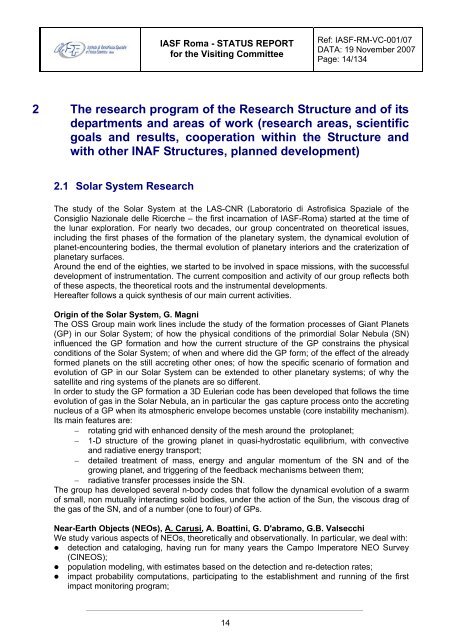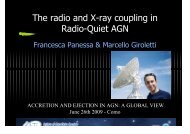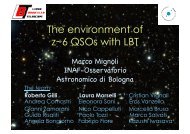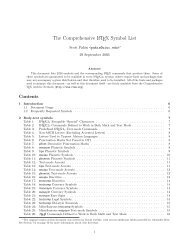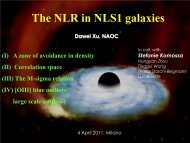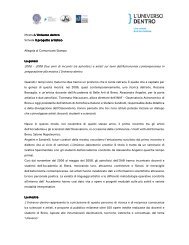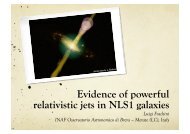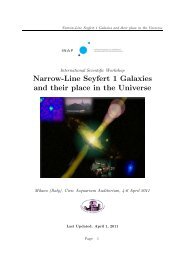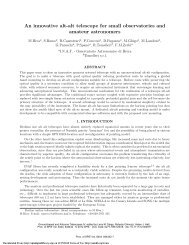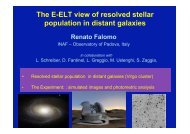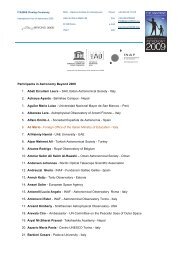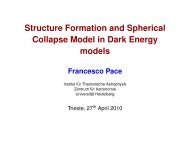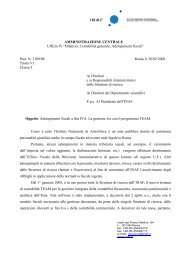<strong>IASF</strong> <strong>Roma</strong> - STATUS REPORTfor the Visiting CommitteeRef: <strong>IASF</strong>-RM-VC-001/07DATA: 19 November 2007Page: 14/1342 The research program of the Research Structure and of itsdepartments and areas of work (research areas, scientificgoals and results, cooperation within the Structure andwith other <strong>INAF</strong> Structures, planned development)2.1 Solar System ResearchThe study of the Solar System at the LAS-CNR (Laboratorio di Astrofisica Spaziale of theConsiglio Nazionale delle Ricerche – the first incarnation of <strong>IASF</strong>-<strong>Roma</strong>) started at the time ofthe lunar exploration. For nearly two decades, our group concentrated on theoretical issues,including the first phases of the formation of the planetary system, the dynamical evolution ofplanet-encountering bodies, the thermal evolution of planetary interiors and the craterization ofplanetary surfaces.Around the end of the eighties, we started to be involved in space missions, with the successfuldevelopment of instrumentation. The current composition and activity of our group reflects bothof these aspects, the theoretical roots and the instrumental developments.Hereafter follows a quick synthesis of our main current activities.Origin of the Solar System, G. MagniThe OSS Group main work lines include the study of the formation processes of Giant Planets(GP) in our Solar System; of how the physical conditions of the primordial Solar Nebula (SN)influenced the GP formation and how the current structure of the GP constrains the physicalconditions of the Solar System; of when and where did the GP form; of the effect of the alreadyformed planets on the still accreting other ones; of how the specific scenario of formation andevolution of GP in our Solar System can be extended to other planetary systems; of why thesatellite and ring systems of the planets are so different.In order to study the GP formation a 3D Eulerian code has been developed that follows the timeevolution of gas in the Solar Nebula, an in particular the gas capture process onto the accretingnucleus of a GP when its atmospheric envelope becomes unstable (core instability mechanism).Its main features are:− rotating grid with enhanced density of the mesh around the protoplanet;− 1-D structure of the growing planet in quasi-hydrostatic equilibrium, with convectiveand radiative energy transport;− detailed treatment of mass, energy and angular momentum of the SN and of thegrowing planet, and triggering of the feedback mechanisms between them;− radiative transfer processes inside the SN.The group has developed several n-body codes that follow the dynamical evolution of a swarmof small, non mutually interacting solid bodies, under the action of the Sun, the viscous drag ofthe gas of the SN, and of a number (one to four) of GPs.Near-Earth Objects (NEOs), A. Carusi, A. Boattini, G. D'abramo, G.B. ValsecchiWe study various aspects of NEOs, theoretically and observationally. In particular, we deal with:• detection and cataloging, having run for many years the Campo Imperatore NEO Survey(CINEOS);• population modeling, with estimates based on the detection and re-detection rates;• impact probability computations, participating to the establishment and running of the firstimpact monitoring program;14
<strong>IASF</strong> <strong>Roma</strong> - STATUS REPORTfor the Visiting CommitteeRef: <strong>IASF</strong>-RM-VC-001/07DATA: 19 November 2007Page: 15/134• follow-up coordination, with the setup of a web-based system that prioritizes the follow up forNEOs in need of observation;• deflection computations, with an algorithm that quantitatively estimates the impulse needed;• modeling of the consequences of NEO impacts on the ecosystem.Moreover, we study numerically and analytically the chaotic dynamics of small bodies inducedby planetary close encounters, the evolution of comets from the Oort to near-Earth space, theidentification of parent bodies of meteoroid streams, and the dynamics of the artificial debrissystem surrounding our planet.Observation of comets, M.T. Capria, M.C. De SanctisWe are performing, in collaboration with the Padua Observatory, a program of high resolutioncomet spectroscopy in the visible range of the spectrum. The aim is to catalogue and identifythe emission lines. Until now, 5 comets have been observed at TNG (Canary Island). We havealso participated in the ground observation campaign in support of the Deep Impact event (July2005).Thermal evolution models of comet nuclei, M.C. De Sanctis, M.T. Capria, G. Magni, R.OroseiTheoretical models of the differentiation and thermal evolution of a nucleus are used to linkobservations with real nuclei characteristics and properties. The model is needed to understandcompositions, structure and physical properties of comet nuclei, foresee dust and gas fluxes,and unveil the physical phenomena inside comet nuclei . Our group developed a complexmodel of thermal evolution of comet nuclei using a quasi 3-D numerical code. This model is oneof the most complete and reliable existing. We have been involved in two international workinggroup (at ISSI) for several years of study of comet nuclei. The book by W. Huebner, J.Benkhoff, M.T. Capria, A. Coradini, M.C. De Sanctis, A. Enzian, R. Orosei, D. Prialnik.,”Heatand Gas Diffusion in Comet Nuclei”, edited in 2006 (ISSI Science Series) summarizes this longactivity.Lunar Exploration, M.C. De Sanctis, P. CerroniThe two main activities of this project concern the AMIE micro-camera for the SMART-1 ESAmission, and the study, carried out on behalf of ASI, of a lunar exploration mission.AMIE is the outcome of a collaboration involving Switzerland, Italy and France. Its primaryscientific goal is the study, by means of high resolution imaging, of the lunar South polar region,and of South Pole Aitken (SPA), the largest impact structure present on the Moon. The cameraweighs only 450 g, and is a masterpiece of miniaturization; Italy has developed the powersupply electronics, as well as the interface with the satellite. The SMART-1 mission ended inSeptember 2006, and our activity for the next triennium will consist of data analysis, calibrationverification, preparation of the data for dissemination and archiving, and public outreach.The study of an ASI lunar exploration mission involves a review of current knowledge, theevaluation of open questions and of the key measurements that could lead to a realadvancement in our understanding of the Moon, the prioritization of these key measurements inview of the scientific objectives, the definition of mission and instruments requirements, and theoptimization of their scientific return.Study of the surface and of the exosphere of Mercury (SIMBIO-SYS), F. Capaccioni, M. T.Capria, P. Cerroni, M.C. De Sanctis, G. FilacchioneSimbio-SYS (Spectrometers and Imagers for MPO BepiColombo Integrated ObservatorySYStem) is an integrated system, for imaging and spectroscopic investigation of the Mercurysurface and exosphere, to be placed on-board the ESA cornerstone mission BepiColombo.Scientific objectives of the experiment are very wide and cover the study of: surface geologyand stratigraphy; relative surface age (through the analysis of impact craters density and15


